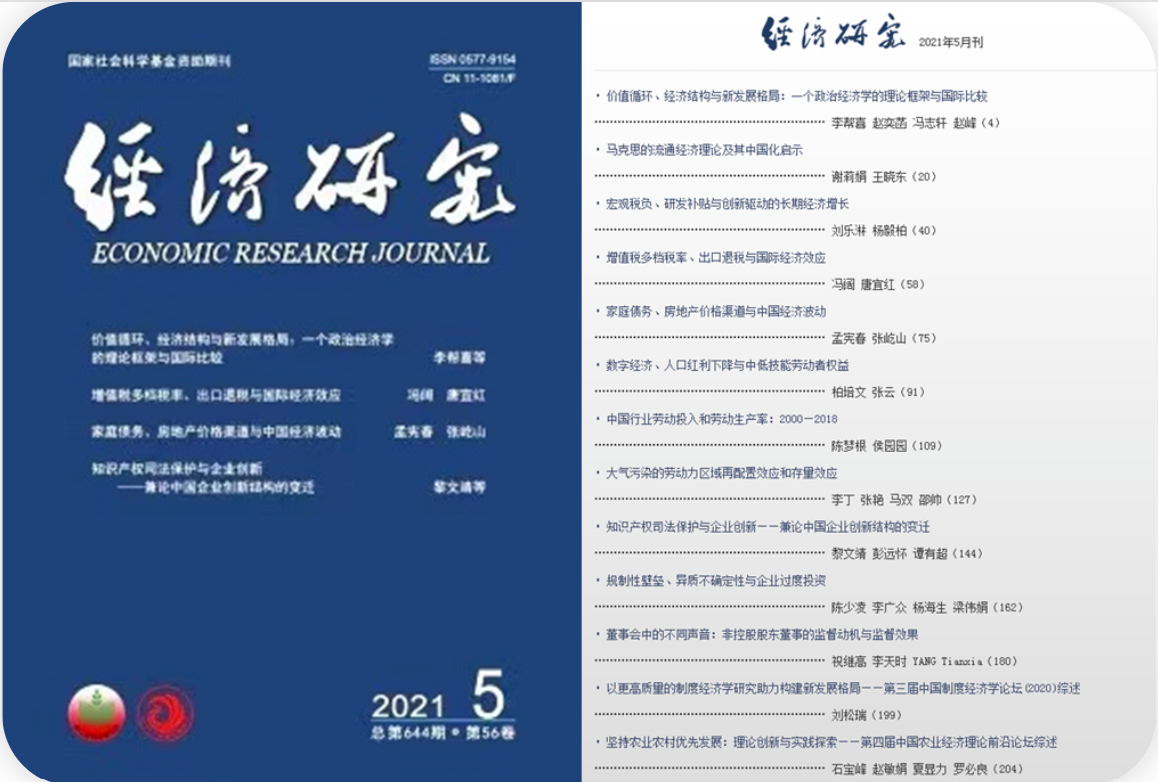岭南观点·23 宏观税负、研发补贴与创新驱动的长期经济增长
刘乐淋讲师、杨毅柏助理教授
我院刘乐淋讲师与澳门大学杨毅柏助理教授合作的学术论文《宏观税负、研发补贴与创新驱动的长期经济增长》在全国性综合经济理论刊物《经济研究》2021年第5期中发表。

随着中国经济步入“新常态”以及中美贸易争端愈演愈烈,科技创新的重要性愈发赢得公众和政策制定者的深刻认同。另一方面,自2018年以来,国务院大力推行“减税降费”政策,以期切实降低各级企业的成本负担,夯实经济发展的长期基础。向研发密集型企业提供税收优惠和补贴的财政政策能够促进创新进程,进而提升长期经济增长。然而,政府同样需要通过税收为其生产性公共支出(比如基础设施建设)进行融资。因此,基于税负调整,研发补贴与生产性政府支出之间出现一个天然的平衡。根据理论模型的显示解,本文充分论证了生产性政府支出、创新和税负之间的互动机制。另外,基于模型校准和实证分析,我们试图找出极大化中国稳态经济增长率的最优税负水平和研发财政补贴政策。所以,本文有助于理解“减税降费”政策的经济增长效应,并为“减税降费”政策提供理论基础。
具体来讲,本文构建了一个基于创新驱动的熊彼特增长框架,将生产性政府支出和宏观税负水平引入质量阶梯模型。模型中,研发企业创造(更先进的)新专利,以提高他们产品(机器)的质量。这些机器是用于生产最终产品的中间产品,且仅由手握最新专利的企业进行生产,因此,手握最新专利的企业能够享受生产机器的垄断利润。这正是研发投资和技术创新乃至长期经济增长的源动力。然而,由于模型中的政府支出是生产性的,这表明促进研发的税收优惠和补贴将缩减生产性公共品的规模,从而阻碍经济增长。
因此,理论模型表明,宏观税负水平对长期经济增长存在倒U型的作用,即如果宏观税负水平大于(小于)某个阈值时,宏观税负水平的提升会显著降低(提高)稳态经济增长率;同时,研发补贴率对稳态经济增长也存在倒U型的作用。并且,最优研发财政补贴政策与税收政策相互依赖,要求政府综合把握政策组合的力度。
根据近十年中国的宏观经济数据,我们对基准理论模型做了谨慎的校准。给定现阶段研发补贴率与研发强度,我国最优宏观税负水平不超过16.9%,且总体税率下降1个百分点则提高长期人均GDP实际增速0.17个百分点;若政府统一协调宏观税负水平和研发补贴率,该政策组合的数值模拟结果表明,最优的宏观税负水平和研发补贴率分别在12.4%-17.8%和41.5%-47.9%之间。考虑到我国现阶段总体税率仍在18%左右,研发补贴率则存在37.5%的上限,因此,2018年以来由国务院主导的“减税降费”政策正合时宜。特别地,模型参数校准表明,中国当前的研发效率仍然偏弱。这呼应了一部分关于中国R&D表现的实证文献结果,也表明中国政府仍有巨大的空间去提升高等教育和R&D投入。随着国家基础科研实力和科研投入的提升,全社会的研发能力将得到有效提高,从而“减税降费”政策对长期经济增长的贡献也将越发显著。因此,本文给出的基准量化结果可视为“减税降费”政策对长期经济增长贡献的下限。
Since China stepped into the era of new normal and the trade disputes between China and the United States have intensified, the importance of technological innovations has been deeply recognized by the public and policymakers. Fiscal policy providing tax incentives and subsidies for R&D-intensive firms is able to facilitate the progress of innovations and the long-run economic growth. However, the government needs to finance its expenditures on productive public goods, for example, infrastructures, via taxes. Therefore, a natural tradeoff appears between R&D facilitation and productive government spending based on the tax burden adjustment. Given that the current aggregate tax burden in China is around 18%, the State Council of China has determined to promote the tax and fees reduction policy since the beginning of 2018. Relying on explicit solutions to the theoretical models, this paper demonstrated the interactions among productive government spending, innovations and tax burden. Moreover, based on the model calibration and empirical analysis, we try to find out the optimal tax burden and R&D subsidy policy that maximizes the steady-state economic growth rate in China. Thus, this paper contributes to understanding the growth effects of and provides ground for the recent tax and fees reduction policy.
Specifically, this paper developed an innovation-based growth framework by introducing productive government spending and aggregate tax burden into the quality-ladder model. In this model, R&D firms create a ( more advanced) new patent to improve the quality of their products (machines). Machines are intermediates in the production of final goods, and only the newest patent holder could produce them and thus enjoys the monopolistic profit. This is the fundamental incentive for R&D investment and technological innovations, which is also the source of the long-run economic growth. However, since the government spending in the model is productive, R&D-promoting tax incentives and subsidies will reduce the room of productive public goods and hinder economic growth.
According to the theoretical model, the aggregate tax burden generates an inverted-U shaped effect on the long-term growth. That is, if the aggregate tax burden is higher (lower) than a threshold, an increase in the aggregate tax burden will reduce (boost) the steady-state economic growth rate. Meanwhile, the R&D subsidy rate has an inverted-U shaped effect on the long-term growth as well. Additionally,the optimal R&D subsidy policy and tax policy depend on each other, which requests the government to balance the policy mix carefully.
Based on the Chinese macroeconomic data during the recent decade, we carefully calibrated the benchmark model. Given the current R&D subsidy rate and R&D intensity, the optimal aggregate tax burden in China is no more than 16.9%, and a one percentage point reduction in the aggregate tax rate will raise the long-term growth rate of real GDP per capita by 0.17 percentage points. If the government is allowed to coordinate the aggregate tax burden and the R&D subsidy rate, according to the numerical simulation with respect to the policy mix, the optimal aggregate tax burden and R&D subsidy rate are 12.4%-17.8% and 41.5%-47.9%, respectively. In China, the current aggregate tax rate is around 18% and the R&D subsidy rate is at the upper limit of 37. 5%, so it is appropriate for the State Council to conduct the tax and fees reduction policy. In particular, the calibrated model parameters show that the R&D efficiency in China is far below that of the United States. This echoes some empirical literature on the performance of R&D in China and reveals tremendous potential for the Chinese government to improve higher education and encourage R&D inputs.
The calibrated parameters in the benchmark theoretical model show that the R&D efficiency in China is still underdeveloped. Along with the enhancement in the basic research and R&D intensity, the R&D efficiency will be significantly improved. Also, the tax and fees reduction policy will increasingly contribute to the long-term economic growth. Thus, the benchmark quantitative results obtained from this paper should be taken as the lower bound for the impact of the tax and fees reduction policy on the long-term economic growth.
刘乐淋
中山大学岭南学院经济学讲师,澳大利亚University of New South Wales经济学博士,曾于Reserve Bank of New Zealand任职Economic Analyst。主要研究领域包括:经济周期、创新与经济增长、货币经济学、时间序列分析与中国经济。论文已发表在《Signal Processing》、《Journal of Economic Dynamics & Control》、《Economic Inquiry》和《经济研究》等国内外权威学术期刊。同时,其主持了国家自然科学基金青年科学基金和中央高校基本科研业务费青年教师培育项目等科研项目,并参与了若干项国家自然科学基金和国家社会科学基金项目。



